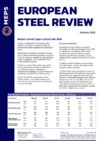EU steel prices weaken further as summer holidays begin
European steel prices continued to weaken this month. The general rate of decrease, however, decelerated. Wide price disparities exist between products and regions.
Stocks at steel distributors and service centres grew. Panic purchases made in March and April were received. Material imported against the new quotas was also cleared from July 1. These purchases are mostly at considerably higher values than current offers from EU producers.
Since Easter, however, demand from consumers slumped. Faced with high stock and low order intake, distributors severely limited new bookings at local suppliers.
Steelworks failed to cut capacity in time to prevent a major deterioration in European steel prices. They held raw material stocks which they opted to consume. Current output still exceeds demand.
Indications are that a bottom may have been reached. Mill costs are close to break-even levels, despite a softening in raw material costs, offsetting some of the reduction in rolled product values. A sudden jump in scrap prices, buoyed by new bookings from Turkey, stabilised commodity prices, at least in the short term.
Efforts by the Chinese government to boost domestic steel demand have yet to bear fruit. Sales in China remain weak, and steelworks are cutting output. This, in turn, will add to downward pressure on raw material costs.
Following European sanctions, Russian steelmakers have diverted sales of slabs and billets to Asia and the Middle East, selling at low prices. Directly and indirectly, these supplies contribute to the import pressure faced by European producers.
The looming threat of gas shortages, within Europe, remains, and with it, the prospect of steelmaking capacity cuts. Nord Stream 1, the pipeline carrying gas under the Baltic Sea from Russia to Germany, in which Gazprom has a 51 percent share, has closed for maintenance. German consumers are concerned that supplies will not resume after the 10 days scheduled.
The German authorities’ plan, for handling potential energy supply disruptions, prioritises domestic users. Heavy industrial consumers, such as steelworks, would be first to cut production. Downstream activity, such as rerolling and wire drawing, would follow suit. Enforced cuts in output would result in upward price pressure as demand simultaneously reduces.
Industry reports regularly feature investments in new and existing manufacturing facilities, which are part of the steel industry’s accelerating drive to “green” steel. These all need to be paid for. In the short term, producers, as well as distributors, can survive on profits from the first half of this year. Very swiftly, however, they must return margins to levels which allow sustainable improvements.
Europe is entering the holiday period, when demand for steel traditionally falls. Planned and extended mill maintenance over the summer will reduce output, easing some of the negative pressure on basis values. This alone will not be sufficient to support prices. A recovery will only happen once buyers need to replenish stocks, after the holidays.

Source:
European Steel Review
The MEPS European Steel Review is an informative, concise and easy-to-use monthly publication, offering unique professional insight into European carbon steel prices.
Go to productRequest a free publication





